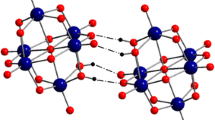Abstract
Purpose: To investigate the effect of temperature on hydrogen bonding in a series of structurally related amorphous and crystalline compounds to gain a better molecular-level understanding of structural differences in the various phases.
Methods: FT-infrared spectra of seven 1,4-dihydropyridine calcium channel blockers were obtained at temperatures between 0 and 200°C using a temperature-controlled attenuated total reflection accessory. Thermal behavior was characterized using differential scanning calorimetry.
Results: Hydrogen bonding was investigated by monitoring the position of the NH stretching vibration, where an increase in peak wavenumber was taken to indicate a weakening of hydrogen bonding. Heating resulted in a reduction in hydrogen bonding strength, which was greatest for liquids and less for glassy and crystalline phases. For the amorphous samples, a plot of NH peak position vs. temperature displayed a discontinuity in the region of the glass transition (determined using differential scanning calorimetry) indicating that hydrogen bonding weakened abruptly as the material passed through the glass transition. This effect was more pronounced for some samples than for others.
Conclusions: The variation in the decrease in hydrogen-bonding interactions with increasing temperature for the different phases is consistent with greater configurational freedom as one moves from crystal to glass to liquid.
Similar content being viewed by others
REFERENCES
G. B. McKenna. Glass formation and glassy behavior. In C. Booth and C. Price (eds.), Comprehensive Polymer Science, Vol. 1, Pergamon Press, New York, 1989, pp. 311–362.
M. D. Ediger, C. A. Angell, and S. R. Nagel. Supercooled liquids and glasses. J. Phys. Chem. 100:13200–13212 (1996).
W. L. Chiou and S. Riegelman. Pharmaceutical applications of solid dispersion systems. J. Pharm. Sci. 60:1281–1302 (1971).
A. T. M. Serajuddin. Solid dispersion of poorly water-soluble drugs: Early promises, subsequent problems, and recent breakthroughs. J. Pharm. Sci. 88:1058–1066 (1999).
J. F. Carpenter, M. J. Pikal, B. S. Chang, and T. W. Randolph. Rational design of stable lyophilized protein formulations: Some practical advice. Pharm. Res. 14:969–975 (1997).
B. C. Hancock and G. Zografi. Characteristics and significance of the amorphous state in pharmaceutical systems. J. Pharm. Sci. 86:1–12 (1997).
X. C. Tang, M. J. Pikal, and L. S. Taylor. A spectroscopic investigation of hydrogen bond patterns in crystalline and amorphous phases in dihydropyridine calcium channel blockers. Pharm. Res. 19:477–483 (2002).
W. F. Wolkers, H. Oldenhof, M. Alberda, and F. A. Hoekstra. A Fourier transform infrared microspectroscopy study of sugar glasses-application to anhydrobiotic higher plant cells. Biochim. Biophys. Acta 1379:83–96 (1998).
D. J. Skrovanek, S. E. Howe, P. C. Painter, and M. M. Coleman. Hydrogen bonding in polymers: Infrared temperature studies of an amorphous polyamide. Macromolecules 18:1676–1683 (1985).
B. Slootmaekers and H. O. Desseyn. Characterization of interand intramolecular hydrogen bonding in the solid state using variable-temperature IR spectroscopy. Appl. Spectrosc. 45:118–120 (1991).
E. Fukuoka, M. Makita, and S. Yamamura. Glassy state of pharmaceuticals 3: Thermal properties and stability of glassy pharmaceuticals and their binary glass systems. Chem. Pharm. Bull. 37:1047–1050 (1989).
R. Fossheim. Crystal structure of the dihydropyridine Ca2+ antagonist felodipine. Dihydropyridine binding prerequisites assessed from crystallographic data. J. Med. Chem. 29:305–307 (1986).
E. T. G. Lutz and J. H. van der Maas. Hydrogen bonds in crystalline carbohydrates. A variable-temperature FT-IR study. J. Mol. Struct. 324:123–132 (1994).
E. T. G. Lutz, Y. S. J. Veldhuizen, J. A. Kanters, J. H. van der Maas, J. Baran, and H. Ratajczak. A varible low-temperature Ft-ir study of crystalline ?-d-fructopyranose and deuterated analogues. J. Mol. Struct. 270:381–392 (1992).
S. Soderholm, Y. H. Roos, N. Meinander, and K. Steinby. Temperature dependence of the Raman spectra of amorphous glucose in the glassy and supercooled liquid states. J. Raman Spectrosc. 31:995–1003 (2000).
R. L. Leheny, N. Menon, S. R. Nagel, D. L. Price, K. Suzuya, and P. Thiyagarajan. Structural studies of an organic liquid through the glass transition. J. Chem. Phys. 105:7783–7794 (1996).
S. L. Shamblin, B. C. Hancock, Y. Dupuis, and M. J. Pikal. Interpretation of relaxation time constants for amorphous pharmaceutical systems. J. Pharm. Sci. 89:417–427 (2000).
Author information
Authors and Affiliations
Corresponding author
Rights and permissions
About this article
Cite this article
Tang, X.C., Pikal, M.J. & Taylor, L.S. The Effect of Temperature on Hydrogen Bonding in Crystalline and Amorphous Phases in Dihydropyrine Calcium Channel Blockers. Pharm Res 19, 484–490 (2002). https://doi.org/10.1023/A:1015199713635
Issue Date:
DOI: https://doi.org/10.1023/A:1015199713635




